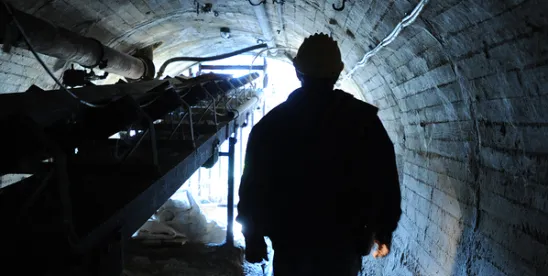Quick Hits
- MSHA recently released a final rule on silica exposure at mines.
- The final rule does not differ drastically from the proposed rule, but the final rule provides longer timelines for compliance.
- The final rule restricts how mine operators can protect miners but lacks meaningful compliance guidance.
- The rule’s effective date for coal mines is April 15, 2025, and the effective date for metal and nonmetal mines is April 8, 2026.
The final rule, titled, “Lowering Miners’ Exposure to Respirable Crystalline Silica and Improving Respiratory Protection,” does not differ drastically from MSHA’s proposed rule. There are changes in the compliance timeline along with some more subtle changes concerning compliance. However, the changes that MSHA declined to adopt are significant.
The following are the key elements of the final rule and how they differ from the proposed rule.
Scope
As with the proposed rule, the final rule covers coal mines and all metal and nonmetal mines. This includes mining contractors and portable mines.
Effective Date
In the biggest substantive change from the proposed rule to the final rule, the final rule gives operators more time to come into compliance with the new regulations. Coal mines have until April 15, 2025, to comply with the new rule; metal and nonmetal mines have until April 8, 2026. In adopting a later compliance date, MSHA acknowledged industry concerns with the availability of sampling equipment. MSHA also hinted that it may consider using enforcement discretion if availability issues continue past the compliance dates.
In part, issues concerning the availability of sampling equipment are due to the adoption of the ISO 7708:1995 standard for dust sampling devices. This change—originally in the proposed rule and unchanged in the final rule—may require mine operators that already have dust sampling devices to modify them or acquire new devices to satisfy the new standard. Mine operators that already conduct dust monitoring and sampling may want to ensure that their equipment satisfies the ISO 7708:1995 standard.
Permissible Exposure Limit
The final rule keeps the proposed permissible exposure limit (PEL) for silica of 50 μg/m3, the same PEL as required by the Occupational Safety and Health Administration’s (OSHA) respirable crystalline silica rule, published in March 2016. MSHA calculates a miner’s exposure to silica by using a full-shift exposure calculated using an eight-hour time-weighted average.
Action Level
While adopting the PEL for silica of 50 μg/m3, the final rule creates an action level of 25 μg/m3 for a full-shift exposure, again calculated as an eight-hour time-weighted average. A sample showing silica at or above the action level triggers additional, periodic sampling under the final rule. This periodic sampling must continue until two successive samples demonstrate silica levels below the action level.
Exposure Monitoring
The final rule requires testing that is extensive and burdensome. By the compliance date, operators must “commence sampling” for any miner who may be expected to be exposed to silica. If that sample is below the action level, operators must still take an additional sample within three months. If that second sample is also below the action level, an operator must still make periodic qualitative evaluations—either semi-annually or when conditions change at the mine that may affect exposure levels. These periodic qualitative evaluations—that must be recorded and posted—may require an operator to conduct additional sampling.
In the proposed rule, MSHA had allowed mines to use objective or historical sample data to establish a baseline of silica exposure and to reduce the initial sampling to one sample below the action level. However, MSHA eliminated this method of compliance in the final rule, potentially increasing drastically the amount of testing operators must undertake. Even with the different compliance dates for coal mines and metal and nonmetal mines, the final rule may result in a bottleneck at the compliance dates with all operators attempting to get multiple samples evaluated at relatively the same time.
Engineering and Administrative Controls
In the final rule, MSHA makes clear that it prefers compliance by engineering controls over administrative controls. Not only does the final rule emphasize engineering controls and allow administrative controls only to “supplement[] … when necessary,” but the final rule explicitly forbids the rotation of miners as an acceptable administrative control. Although rotating miners out of work that exposes them to silica would inevitably lower a miner’s exposure to silica, MSHA declined to modify this restriction in the final rule.
Respiratory Protection
In a broader change, the final rule incorporates the respirator standard of ASTM F3387-19 for all airborne contaminant standards. This standard applies to the selection, fit, use, and maintenance of approved respirators.
More significantly, the final rule, as with the proposed rule, does not allow the use of respiratory protection for compliance, despite the final rule recognizing that respiratory protection protects miners from silica. This is a departure from OSHA’s silica rule. In recognition that respiratory protection protects miners from silica, the final MSHA rule allows the use of respiratory protection while engineering controls are developed and implemented and if respiratory protection is necessary by the nature of the work. Work where respiratory protection is necessary includes “occasional entry into hazardous atmospheres to perform maintenance or investigation.”
No Table 1
Under the OSHA silica rule, OSHA provided a Table 1 that specifies control measures for certain tasks that would, if implemented, achieve compliance and avoid the extensive sampling regimen. In the final rule, MSHA declined to adopt a similar Table 1.
Medical Surveillance for Metal and Nonmetal Mines
The final rule requires metal and nonmetal mine operators to offer medical surveillance at no cost to miners. MSHA did not adopt job-transfer rights for metal and nonmetal miners as they exist for coal miners under 30 C.F.R. Part 90. However, MSHA did state that it “intends to consider this issue in a future rulemaking.”
Recordkeeping
The final rule contains details recordkeeping requirements. These include keeping all evaluation, sampling, and corrective action records for at least five years. This constitutes a new substantial administrative requirement on mine operators.
Key Takeaways
Overall, the final rule is a dramatic change from the existing standard. Unfortunately, MSHA did not accompany this dramatic change with correspondingly helpful guidance. MSHA offered little guidance on how to lower miners’ exposure to silica. Instead, MSHA only restricted how mine operators can act to protect miners—eliminating the rotation of miners and the regular use of respiratory protection as compliance. In addition, MSHA refused to adopt a “Table 1,” guidance that may have protected miners.
It is almost certain that this new rule, when fully implemented, will be a focus of aggressive enforcement by MSHA. By not providing more guidance and limiting what effective actions a mine operator may take to protect miners, it appears that MSHA has chosen to work against, rather than with, mine operators to achieve the common goal of ensuring miner health and safety. Hopefully, MSHA will correct this impression and use the time before the compliance dates to work with mine operators to successfully improve the health and safety of miners.
In the time before the compliance dates, mine operators may want to prepare for the required sampling, monitoring, and record keeping. Although objective or historical sample data cannot lessen the sampling burden once the compliance dates arrive, they, along with pre-compliance sampling, may give a mine operator an idea where improvements might be needed.
Ogletree Deakins’ Workplace Safety and Health Practice Group will continue to monitor developments and will provide updates on the Mine Safety blog as additional information becomes available.




 />i
/>i
